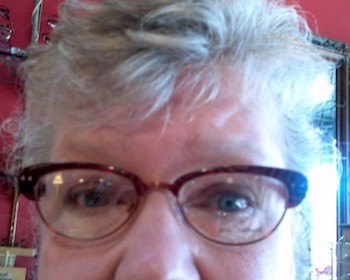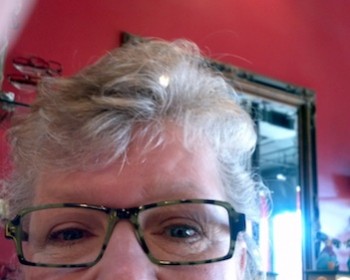There’s a lot of talk about content marketing lately. Content is now king! Everyone is spewing out blog posts, articles, tweets, Instragram images, and Facebook posts in an unending stream of words. The trouble is, very few people seem to be tailoring that content to the audience they are trying to reach. Unfortunately for them, the audience can (and should) influence the content. I have even seen posts on Google Plus that were copy/pasted from Facebook (even down to asking for “likes”).
The trouble with that is that each audience is different. Aside from silly mistakes such as forgetting to substitute +1 for “like” savvy content marketers need to adjust their pitches and their messages to fit each specific audience.
Here’s why that matters


This is my friend Pat Ferdinandi. Her face is a bit swollen in these pictures because she fell (she’s OK, just bruised). When she fell, she broke her glasses and went to get new ones.
At the optometrist, she took two pictures, one with green glasses and one with red. Then she asked her friends on Facebook and on Google Plus which style they liked better (without telling them which pair she’d bought).
You might think that since the two groups were both connected to Pat that they would have quite a lot in common and share similar opinions.
Here’s the interesting part.
She got different answers.
Her friends on Google Plus liked the green glasses. Her followers on Facebook preferred the red ones.
Same question, two audiences, two different results.
What does this mean for marketing?
If you’re using social marketing (or any marketing), adjust your message, your style, and your content to fit your audience. Different groups will have different problems and concerns, and one size (message) might not be right for all.
This holds true both online and offline.
How your audience influences content
Let’s suppose Pat was selling tips on making videos (which she does), and she had two speaking engagements for audiences who wanted to learn more about creating videos.
The first one is at a community center in town, for talk to an audience of home computer users. They want to learn the basics of making videos so that they can put videos on Youtube and send messages to their kids and grandkids. They’re not terribly computer savvy, and want easy, quick, solutions, that aren’t too technically oriented.
Change your message to fit your audience
The second event is a Chamber of Commerce meeting for small business owners. They want to know how to use videos for online classes, a business channel on Youtube, and promotional videos on their sites or blogs. This group has no interest (or time) in do-it-yourself; they’re more focused on marketing, presentation skills, and looking good on camera.
Even if Pat sells them the same information/help (how to make videos), she’d talk about different specific topics, and use different language (more tech-oriented for the businesses, less so for the grandmas) — changing her message to fit her audience.
Oh, and she bought the green ones.
(photos by Pat Ferdinandi; used with permission)




